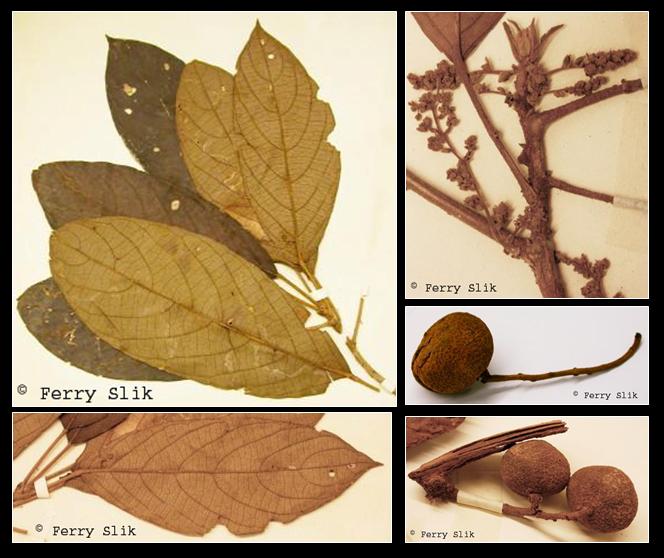Baccaurea edulis Merr., Univ. Calif. Publ. Bot. 15 (1929)
Latin for 'edible'.Description
Tree 8-33 m high, dbh 5-60 cm, buttresses absent to up to 4 m high by 1 m wide, thin; branchlets glabrous,
densely hairy when young, Terminalia branching pattern weakly developed. Indumentum of simple and stellate
hairs. Bark pale to red-brown when fresh, brown when dry, c. 0.5 mm thick, smooth, hard to soft; inner bark
light red to red-brown to yellow to pale brownish, 2-10 mm thick, soft, sometimes brittle. Heartwood red-brown.
Leaves: petiole 12-77 mm long, densely hairy, raised glands absent; stipules triangular to elliptic, 6-11 by
2.5-4.5 mm, sparsely to densely hairy outside, (sub)glabrous inside, margin ciliate, not hyaline; lamina
usually elliptic, 8.3-29 by 3.2-11.8 cm, l/w ratio 2.3-3.8, papery; base rounded to cuneate; marginal glands
often visible as small indentations; apex acute to cuspidate, 3-20 mm long; upper surface glabrous, midvein
usually densely hairy, dark green when fresh, dark brown when dry; lower surface subglabrous to densely hairy,
raised glands usually absent, discoid glands present, yellowish green when fresh, light brown (to green-brown)
when dry; young leaves with yellowish brown indumentum; secondary veins (7 or) 8-10 per side, closed at margin;
nervation reticulate, white (to light brown) above when dry. Staminate inflorescences axillary to just below
the leaves, solitary to few clustered together, 1.5-12.5 cm long, c. 1 mm thick, branched, densely hairy,
many-flowered, flowers scattered along inflorescence; bracts usually 1 per branchlet, spatu-late, 1-4 mm long,
densely hairy outside, (sub)glabrous inside, margin ciliate, not hyaline; bracteoles absent; cymules variable
in shape, 3-18-flowered, densely hairy. Staminate flowers 1-2.5 mm diam., yellowish green to yellow to white;
pedicel 0.5-1.7 mm long, upper part 0.3-1.5 mm long, densely hairy; sepals 4 or 5, ovate to elliptic, 0.7-1.5
by 0.5-1 mm, apex recurved, outside and inside densely hairy; stamens (3 or) 4 or 5, 0.2-0.4 mm long, glabrous;
filaments 0.1-0.3 mm long, straight; anthers 0.1-0.2 by 0.15-0.2 by c. 0.1 mm, pale yellow; pistillode absent
to present, globose, up to 0.2 mm high, densely hairy, solid. Pistillate inflorescences ramiflorous to cauline,
2-6 clustered together, 2-18 cm long, 1-1.5 mm thick, densely hairy, 10-25-flowered, green; pedicel 3-7.8 mm
long, upper part 0.5-1.5 mm long, densely hairy; bracts persistent, 1(-3) per branchlet, subglabrous to
sparsely hairy outside, glabrous inside, margin ciliate. Pistillate flowers 3-7 mm diam., greenish yellow;
sepals 4 or 5, ovate, 2-3.5 by 1-2 mm, outside and inside densely hairy, persistent; ovary globose, 2-4 by
1.5-4 mm, 2-locular, densely hairy; style 1-2 by c. 1 mm, densely hairy; stigmas 1-2 mm long, cleft for upper
90%, caducous (to persistent); lobes 1-2 by c. 1 mm, glabrous above, densely hairy below. Infructescences 2-4
mm thick. Fruits globose, 2-4-seeded berries, 5-6 cm diam. when fresh, 23-60 by 23-60 by 23-60 mm when dry,
raised glands absent, glabrous outside, densely hairy when young, subglabrous to densely hairy inside,
(orange-)brown to whitish to yellow; pericarp 4-10 mm thick; column 19-25 mm long, straight; pedicel 5-14
mm long, upper part 1-6 mm long. Seeds globose to ellipsoid, laterally flattened, 13-20.5 by 8-21 by 2-8 mm;
arillode white to yellow; cotyledons 11-12 by 10.5-16 by 0.1-0.4 mm; radicle 1-1.5 mm long; endosperm 1-2 mm
thick. [from Blumea Suppl. 12: 1--216 (2000)]
Ecology
In undisturbed mixed dipterocarp and swamp forests up to 700 m altitude. Mostly on sandy ridges.
Uses
The fruits are edible, sweet-sour, and sold in local markets.
Distribution
Borneo.
Local names
Borneo Apor-apor, Kapul, Kapul putih, Kulibon, Pasin, Pendal nyumbo, Puak, Pugi,
Tampoi, Tampoi hutan, Tampoi merah.
